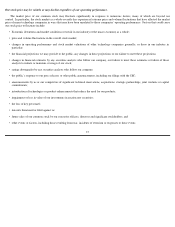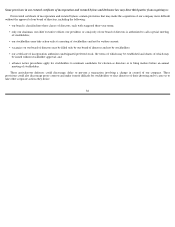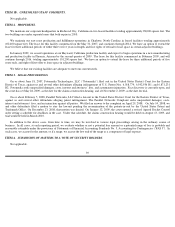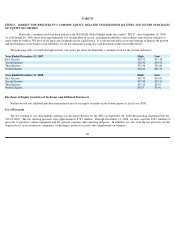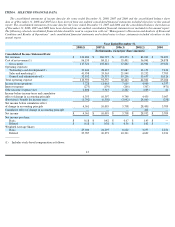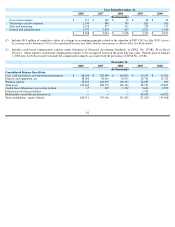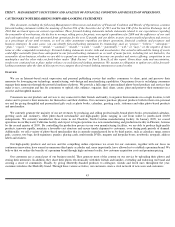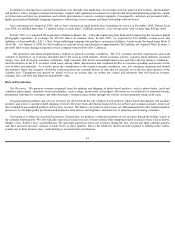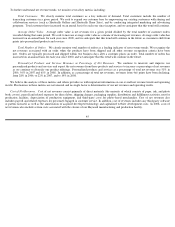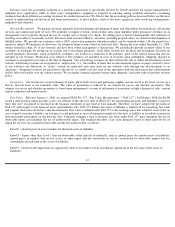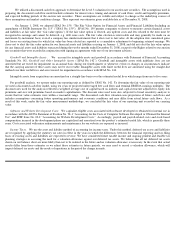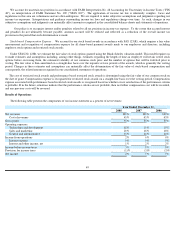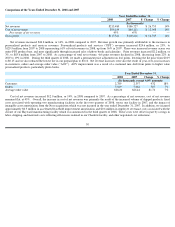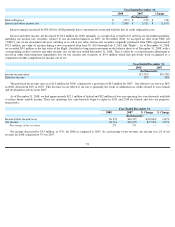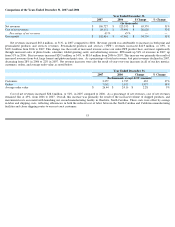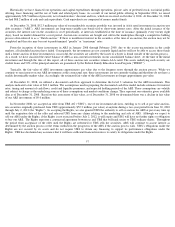Shutterfly 2009 Annual Report Download - page 49
Download and view the complete annual report
Please find page 49 of the 2009 Shutterfly annual report below. You can navigate through the pages in the report by either clicking on the pages listed below, or by using the keyword search tool below to find specific information within the annual report.
In many cases, the accounting treatment of a particular transaction is specifically dictated by GAAP and does not require management’
s
judgment in its application, while in other cases, management
’
s judgment is required in selecting among available alternative accounting
standards that allow different accounting treatment for similar transactions. We believe that the accounting policies discussed below are the most
critical to understanding our historical and future performance, as these policies relate to the more significant areas involving management’
s
judgments and estimates.
Revenue Recognition. We generate revenues primarily from the printing and shipping of prints and other photo-
based products, advertising
services and commercial print services. We generally recognize revenues from product sales upon shipment when persuasive evidence of an
arrangement exists (typically through the use of a credit card or receipt of a check), the selling price is fixed or determinable and collection of
resulting receivables is reasonably assured. Revenues from amounts billed to customers, including prepaid orders, are deferred until shipment of
fulfilled orders. We provide our customers with a 100% satisfaction guarantee whereby products can be returned within a 30-
day period for a
reprint or refund. We maintain an allowance for estimated future returns based on historical data. During the year ended December 31, 2008,
returns totaled less than 1% of net revenues and have been within management’
s expectations. We periodically provide incentive offers to our
customers in exchange for setting up an account and to encourage purchases. Such offers include free products and percentage discounts on
current purchases. Discounts, when accepted by customers, are treated as a reduction to the purchase price of the related transaction and are
included in net revenues. Production costs related to free products are included in costs of revenues upon redemption. Shipping charged to
customers is recognized as revenue at the time of shipment. Our a
dvertising revenues are derived from the sale of online advertisements on our
website. Advertising revenues are recognized as “impressions” (
i.e., the number of times that an advertisement appears in pages viewed by users
of our websites) are delivered; as “clicks” (
which are generated each time users on our websites click through our advertisements to an
advertiser’
s designated website) are provided to advertisers; or ratably over the term of the agreement with the expectation that advertisement
will be delivered ratably over the contract period. We recognize commercial print revenue upon shipment, consistent with our product revenue
policy.
Inventories.
Our inventories consist primarily of paper, photo book covers and packaging supplies and are stated at the lower of cost on a
first-in, first-
out basis or net realizable value. The value of inventories is reduced by an estimate for excess and obsolete inventories. The
estimate for excess and obsolete inventories is based upon management’
s review of utilization of inventories in light of projected sales, current
market conditions and market trends.
Fair Value . Effective January 1, 2008, we adopted SFAS No. 157, “Fair Value Measurements” (“FAS 157”).
In February 2008, the FASB
issued a staff position which provides a one year deferral of the effective date of SFAS 157 for all nonfinancial assets and liabilities except for
those that were recognized or disclosed in the financial statements at fair value at least annually. Therefore, we have adopted the provision of
FAS 157 with respect to our financial assets and liabilities only. FAS 157 defines fair value, establishes a framework for measuring fair value
and expands disclosures about fair value measurements. Fair value is defined under FAS 157 as the exchange price that would be received for an
asset or paid to transfer a liability (an exit price) in the principal or most advantageous market for the asset or liability in an orderly transaction
between market participants on the measure date. Valuation techniques used to measure fair value under FAS 157 must maximize the use of
observable inputs and minimize the use of unobservable inputs. The standard describes a fair value hierarchy based on three input levels, of
which the first two are considered observable and the last unobservable, as follows:
Level 1 – Quoted prices in active markets for identical assets or liabilities
Level 2 –
Inputs other than Level 1 that are observable, either directly or indirectly, such as quoted prices for similar assets or liabilities;
quoted prices in markets that are not active; or other inputs that are observable or can be corroborated by observable market data for
substantially the full term of the assets or liabilities.
Level 3 – Unobservable inputs that are supported by little or no market activity and that are significant to the fair value of the assets or
liabilities.
47


